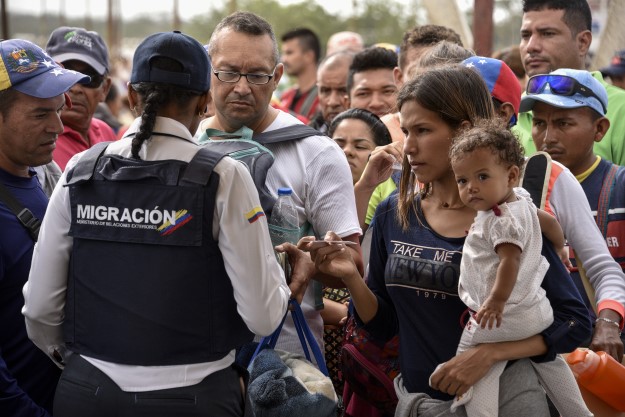BOGOTÁ – While denouncing and trying to prevent migration has become the new normal in international policy, Colombia has taken a different tack, keepings its doors open to thousands of new arrivals from Venezuela despite significant short-term costs. Researchers at Fedesarrollo estimate that healthcare, education and social assistance for migrants cost Colombia’s government between 0.2% and 0.4% of GDP each year. (The government itself sets the number slightly higher, at 0.5%.)
There are several reasons Colombia has been able to assume this responsibility, many of them to do with decades of macroeconomic stability that has been far from the norm elsewhere in the region.
Of course, Colombian policymakers know that Venezuelan migration will mean medium- and long-term benefits for the country. At Fedesarrollo we estimate that migrants will add an additional 0.1% to 0.2% to economic growth during the next decade, thanks to an increase in labor force participation and the demographic dividend of the relatively young migrants.
But even before the influx, Colombia was faring better than its neighbors in economic terms. According to official statistics, the economy grew 3% on average during the first half of 2019. To put this figure in perspective, the IMF expects Latin America to grow at 0.6% this year, with Brazil and Mexico, the region’s largest economies, forecasted to grow just below 1%.
One reason why Colombia has been able to maintain relatively healthy rates of growth despite a worsening international environment, including increased trade tensions and the arrival of around 1.5 million Venezuelan migrants over the last three years, lies in the country’s long history of economic resilience.
An outlier in Latin America
Of the past 112 years, Colombia has had negative growth in just three: in 1930 and 1931, during the Great Depression, and in 1999, during the Russian and emerging market crises. In modern economic times, Colombia is among the only economies in the region not to endure a hyperinflationary episode, and still maintains its early 20th-century currency. It has not defaulted on its public debt since the 1930s, and did not go through a debt-restructuring episode in the 1980s, Latin America’s “lost decade.”
More recently, Colombia has enjoyed high growth rates based on improved security conditions and the head winds of very favorable oil prices, Colombia’s main export. The average growth rate from 2000-2014 was 4.3%, well above the regional average of 3.2%. Due to a fall in oil prices, average growth fell to 2.3% in 2015-2018, still far better than Latin America’s 0.7% observed growth rate in the same period. This important difference in outcomes serves to emphasize the strong resilience of Colombia’s economy.
But what are the fundamental factors behind this stability? Economic historians, based on comparative evidence, have emphasized the strength of Colombia’s economic institutions, staffed by well-trained technocrats who have managed to implement prudent fiscal and monetary policies. An interesting question for future research is how this equilibrium has been possible in a country that withstood the longest armed conflict in the Western Hemisphere, while at the same time countries like Argentina, which also has highly skilled human capital, seem destined to endure a crisis at least once a decade.
The challenges ahead
But despite the strong performance of the Colombian economy, important challenges remain. Politically, these start with the consolidation of the peace process. The demobilization of the FARC has unlocked important opportunities for growth in the agricultural and tourism sectors, among others. But these opportunities demand that the armed forces move in quickly to territories where the FARC was strongest. It also means removing the threat of FARC dissidents and the ELN, another guerrilla group that, time and time again, has failed to show willingness to negotiate with the government.
To this end, the recent announcement by several of the FARC’s top negotiators that they would abandon their posts in Congress and re-arm highlights the need to speed up policies that would help re-establish rule of law in some municipalities. Although more than 95% of the 13,202 demobilized FARC soldiers are still in the process of reintegrating to their local communities, the small number of dissidents poses a significant risk. The government will need to move quickly to prosecute dissidents and implement development plans in conflict zones to provide jobs and much-needed public goods to dissuade others from joining their ranks.
On the economic front, the key challenge lies in increasing potential growth. While average GDP growth slightly above 3% seems good relative to the rest of the region, it is still below what the country needs to bring down the unemployment rate, which currently hovers around 10.4%, and to continue reducing poverty and extreme poverty, which stand at 27% and 7.2% of total population respectively.
A recent tax reform, which reduced corporate income tax rates and introduced a simplified tax system for small and medium enterprises, should go some way in addressing this challenge. But more is needed. The structural reform agenda should aim for export diversification, both to reduce external balance dependence on oil prices and to increase exports and productivity growth. Human capital formation, by increasing the quality and relevance of education in a rapidly changing work environment, is also key. Finally, the government should focus on environmental sustainability, with a vision of growth that is compatible with cleaner energy demand and an expansion of green practices across the production spectrum.
The challenges are significant, but if history is a guide, a balance between political will and a traditionally strong technocracy will continue to move Colombia towards growth, equity and sustainability.
—
Mejía is the Executive Director of Fedesarrollo, one of Latin America’s most recognized think tanks. He was Deputy Minister and Minister of Planning of Colombia from 2014-2018, leading the ministry in its implementation of the Sustainable Development Goals agenda. He has also held positions as Director for Macroeconomic Policy at Colombia’s Ministry of Finance, as well as researcher at Colombia’s Central Bank and the Inter-American Development Bank in Washington. Follow him on Twitter @LuisFerMejia









